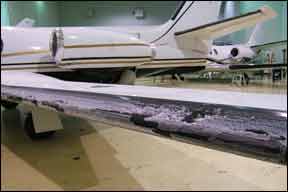The only time ice on the airframe is a good thing is when it’s tied down and you really didn’t want to go flying today, anyway. Otherwise, it’s always something to be avoided. As we all should have been taught, ice adhering to the wings, tail and other components tends to add weight and drag. If it forms on an airfoil, the surface’s lift characteristics can be dramatically different, in addition to the weight and drag. Bad karma all around.

288
But ice can affect other systems, too. The pitot/static system is problematic, as is the electrical system, as more current is demanded to keep things warm. Depending on the aircraft, ice also can extend the landing gear, fail an engine or cause critical electrical failures. The NASA Aviation Safety Reporting System (ASRS) recently updated one of its database report sets, the one covering icing incidents among commuter and general aviation aircraft. The incident descriptions have several lessons for us and highlight airframe icing’s complications, even if having the stuff on the airfoils turns out not to be a factor.
Airplane Configuration
A Cessna Stationair, powered by a single turbine engine, experienced a flame out shortly after being cleared for an ILS. “I declared an emergency to ATC,” wrote the pilot. “I applied the alternate induction and intake anti-icing system and unsuccessfully attempted to restart the turbine. Losing altitude at a high rate I feathered the propeller and established best glide speed. A second attempt to restart was successful.”
The pilot managed to keep things together, recover his altitude, break out of IMC and safely land. Later, after a probable underwear change, he contacted the engine manufacturer to review its recommendations and determine potential causes for the flameout. The pilot wrote, “The procedure when flying in visual moisture and near freezing temperatures is to have the alternate induction open and the intake anti-icing on. Because I was not seeing any ice formation on the airframe I didn’t activate the procedure.” Yet, somewhere along the way he picked up enough ice to starve the engine of air, causing the flameout. Once emergency engine re-start procedures were employed, the fire re-lit and all was well.
Our first lesson, then, is that a relatively small amount of ice—the Cessna’s flight characteristics apparently weren’t affected—can block an induction intake sufficiently to shut down an engine unless it’s properly configured. In fact, limitations on the specific engine/airframe combination called for alternate induction and an activated anti-icing system in temperatures as warm as 40 deg. F. So, reviewing icing procedures on the ground, well before entering the stuff, isn’t a bad idea, either.
On The Ground
Most of the warnings about airplanes and icing involve ice accumulating while airborne. That same weather’s effect on the ground can be a concern, also. A freight dog, flying a Piper Navajo, picked up ice that didn’t succumb to the anti-icing systems. “As a rule of thumb, if the airplane airspeed falls below 150, the pilot needs to take evasive action to get out of it,” wrote the pilot. “I was actually down to 140 KTS in level flight but I was close enough to destination that I needed to start a descent to get set up for the approach,” he reported.

288
With a decent weather observation at his destination, he gave up altitude for airspeed in a descent for the approach. While receiving vectors, ATC advised the weather was going down. “The visibility had dropped to ¼ [mile]. I elected to do the ILS approach rather than hold due to the ice the airplane had already encountered. I landed without incident with the actual visibility almost one mile.” Did the weather miraculously improve? No—it was never that bad. ”[T]rucks were plowing the runway and the wind was blowing in the right direction so that the snow off the runway was moving over the [visibility] sensor.”
A Skyhawk driver taking off on an ice runway lost directional control upon applying full throttle for takeoff. “The plane began to yaw left and started skidding off the runway surface. After realizing I did not have the airspeed or directional control to rotate and lift the plane off the ice safely, I pulled the power and tapped the right brake. The tail of the aircraft then once again began to align with the nose.”
What do these two incidents have in common? Both challenges arose because of conditions on the ground, not in the air. Even if we successfully aviate through the icing conditions, the situation on the ground—for which we may not be prepared—also can work against us. More bad karma.
Déjà Vu, all over again?
The advent of advanced avionics also has ushered in new and different failure modes: If one system fails, it can take with it another, more critical one. The pilot of a glass panel-equipped V-tail Bonanza learned this the hard way.
The pilot encountered unforecast light icing conditions and turned on the pitot heat. Shortly thereafter, the “pilot lost [the] primary guidance system (attitude indicator, HSI, airspeed indicator, electronic altimeter and VSI).” Additionally, the autopilot disengaged and the pilot had his hands full transitioning to the secondary instruments. He lost 600 feet before recovering and climbing back to his cruising altitude.
“The pilot stated that he simply forgot to turn the pitot heat on until after he was IMC. By then the moisture had accumulated in the pitot tube and had become frozen enough that it was apparently solid and so would take time to thaw and exit the aft pitot tube,” the ASRS said. The pilot’s Aspen PFD installation lost its airspeed input, normally a relatively simple affair in a steam-gauge airplane. It faulted, taking away the primary instrumentation and failing the autopilot, which was driven by the Aspen’s HSI output. Notably, his backup instrumentation continued functioning.
This is very similar to what happened aboard Air France Flight 447, an Airbus 330 lost over the Atlantic Ocean on June 1, 2009. That occurrence of iced-over pitot tubes ended only after an out-of-control descent from FL390 to the water.
Auto-Extending Gear
A glass panel is not the only automated system depending on ice-free pitot tubes. Some airplanes are equipped with automatic landing-gear extension systems designed to prevent gear-up landings. They work by sensing airspeed and engine power—either through a fuselage-mounted pitot-like mast or a switch on the throttle linkage—to energize the landing gear extension system when both airspeed and power are low. They also have overrides, which should be engaged when in icing conditions. One PA-32R pilot didn’t, and got a systems-management refresher course while being vectored for an ILS.
The airplane apparently suffered a directional gyro failure and missed its first approach attempt. While receiving no-gyro vectors for a second attempt, the pitot heat circuit breaker was discovered open and was reset. “As we were being vectored in, the airspeed indication dropped to zero and the altimeter stopped moving,” the pilot wrote. “That lasted for about 10 to 15 seconds, but during that time the gear horn came on again and the main gear dropped.”
While recovering, the Piper crossed the localizer and descended below its assigned altitude, entering clear air a few miles from its destination. “The rest of the approach and landing were uneventful. Our problems were not recognizing the gyro precision error, not checking circuit breakers, and not overriding the ‘Auto Gear Extension system.’”
Anti-Icing System Failures
Even systems we fully understand and checked as functional before takeoff can fail, sometimes in innovative ways. And even if they don’t fail outright, instrumentation can be faulty or the flight’s duration can deplete the anti-icing system’s supplies. Both happened to a pilot flying a Cessna Caravan equipped with a TKS anti-icing system.
“During my post-flight inspection of the aircraft, I observed that the TKS system fluid supply was completely depleted,” the Caravan pilot reported. “Throughout the entire flight duration the cockpit TKS gauge indicated full.” The Caravan pilot went on to note the TKS system’s reservoir was a limiting factor for flight in icing conditions. “[W]hile flights are normally limited in duration due to fuel supply and regulatory requirements, TKS brings with it the same considerations concerning its fluid supply while planning and conducting flight operations in icing conditions.”
While in cruise at 11,000 feet, a Cessna 404’s pilot encountered moderate icing well below its expected altitude. “Normal cruise power results in 150-160 KTS IAS in level flight in this aircraft,” he reported. “As the flight progressed my IAS dropped as low as 120 KTS. It was at this point I began to experience buffeting in the flight controls.” The pilot “immediately declared an emergency” and requested lower altitudes. Upon reaching 7000 feet, “the accumulated ice on the non-protected parts of the aircraft” began melting. The buffeting ended when the initial descent began, perhaps due to increased air flow over the tail. The pilot suspected a failed de-icing boot on the tail, but an inspection uncovered no anomalies.
The lessons? Even an airplane certified for known icing conditions can experience a failure in a related system. It can be tough sledding if the wrong system component fails at the wrong time. Our Caravan pilot again: “[M]y future selection of an alternate airport should be within the TKS” storage tank’s capacity as well as meet fuel requirements.
How’s Your Karma?
The equipment we carry to combat airframe icing varies widely, but it’s all there for one basic reason: to allow us to get out of the icing conditions. Airplanes approved for known-ice situations obviously carry more equipment to fight the stuff than the non-approved variety, but there’s no rule that says the equipment always works. And even when it’s working, performance can suffer and other systems can fail.
For the most part, these examples involved qualified pilots operating in conditions for which they were trained and prepared. In all of them, some degree of luck—karma?—figured prominently. In most of them, the pilots’ skill and training allowed them to recover and land safely.
The bottom line in all this, though, is that no matter how good we are on instruments, no matter how well-equipped we are and no matter how we plan the flight, airframe icing can have unintended and unexpected consequences.
Jeb Burnside is this magazine’s editor-in-chief. He’s a 3000-hour instrument-rated ASEL/ASES/AMEL commercial pilot and aircraft owner.




